Current Trends in Engineering Science
[ ISSN : 2833-356X ]
Can Earth as a Level 1 Civilization control Plate Tectonics and eliminate Earthquakes by harnessing the Energy of the Planet?
MerSETA Chair for Research Development Engineering Faculty, Walter Sisulu University East London, South Africa
Corresponding Authors
Keywords
Abstract
Globally, approximately 44 TW of geothermal heat is transferred through convection from the earth’s core to the surface. The largest portion of this heat (30 TW) is generated by radioactive decay in the core and mantle of the Earth. The difference (14 TW) indicates continuous cooling of the Earth, mainly through the oceans.
The Kardashev Scale classifies a Type 1 civilization’s energy consumption to be estimated at 40 TW, capable of harnessing the energy of its planet. In comparison, earth’s electrical energy generation in 2019 was estimated at about 7.5TW. The Kardashev Scale was later modified and expanded by ?irkovi? and Michio Kaku to include an additional requirement that earth as a Type -1 civilization must control the crust of the planet (eliminate earthquakes).
Research shows that the energy available within 80km on both sides of the 80000km long oceanic ridges of this planet is estimated at approximately 10TW. Indications from the only oceanic ridge geothermal harvesting example in Iceland are that it may delay large earthquakes, implying a reduction in crustal movement. If the future engineering and construction technology is advanced enough, it could be possible to harvest a significant amount of geothermal energy at oceanic ridges deep below the ocean’s surface and reduce seafloor spreading, which is one of the main drivers behind plate tectonics and earthquakes: - A benefit while harvesting a significant amount of clean renewable energy, the energy of the planet
Introduction
Kardashev [1], classified civilizations in the universe based on their energy consumption. A Type I civilization’s energy consumption is estimated at 40TW, capable of harnessing the energy of its planet. It is a level to which earth is moving towards to. In comparison, earth’s electrical energy generation in 2019 was estimated at about 7.5TW [2]. The Kardashev Scale was later modified by Ćirković [3] and expanded by Michio Kaku [4], apart from the energy requirements, to become a Type 1 civilization. A requirement is that earth must control the crust of the planet (eliminate earthquakes).
The estimated energy available within 80km on both sides of the 80000km long oceanic ridges of the planet is estimated at approximately 10TW. Indications from the only oceanic ridge geothermal harvesting example in Iceland are that it may delay large earthquakes (Flóvenz et al. 2015). If engineering and construction technology is advanced enough, it could be possible to harvest a significant amount of geothermal energy at oceanic ridges deep below the ocean’s surface. The purpose of this short paper is to argue that it could be possible to stop, or at least delay the occurrence of large earthquakes while harnessing the energy of the planet.
The estimated energy available within 80km on both sides of the 80000km long oceanic ridges of the planet is estimated at approximately 10TW. Indications from the only oceanic ridge geothermal harvesting example in Iceland are that it may delay large earthquakes (Flóvenz et al. 2015). If engineering and construction technology is advanced enough, it could be possible to harvest a significant amount of geothermal energy at oceanic ridges deep below the ocean’s surface. The purpose of this short paper is to argue that it could be possible to stop, or at least delay the occurrence of large earthquakes while
harnessing the energy of the planet.
Geothermal energy from the earth is approximately 44TW of heat which migrates through convection from the core to the surface (Figure 1). The larger portion of this heat (30TW) is generated by radioactive decay in the core and mantle.
Geothermal energy from the earth is approximately 44TW of heat which migrates through convection from the core to the surface (Figure 1). The larger portion of this heat (30TW) is generated by radioactive decay in the core and mantle.
Geothermal energy will decrease over the next 500-1000Ma and will eventually cease when the planet dies. This time scale implies that geothermal energy is a dependable energy source for the future. There are specific geological areas, such as rifts and oceanic ridges, which transport energy at much higher temperatures closer to the surface.
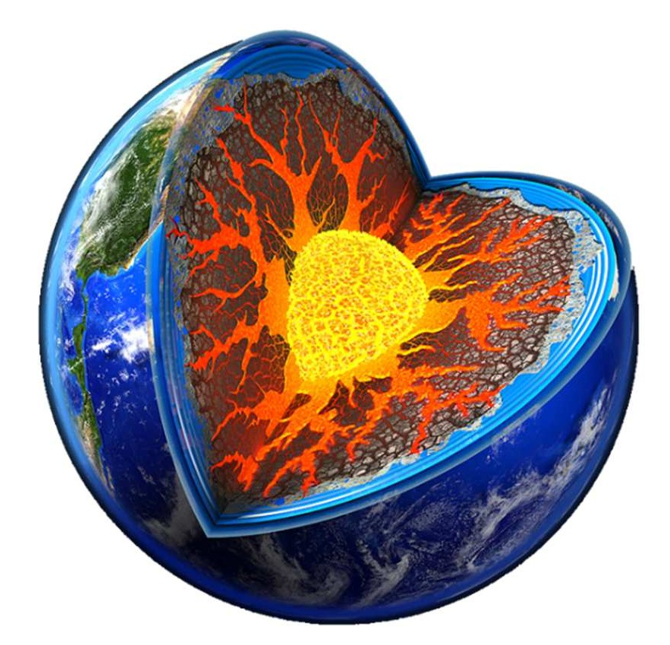
Figure 1: Geothermal energy source of the Earth.
Plate Tectonics and Oceanic Ridges
Oceanic ridges are the divergent plate boundaries of oceanic plates and are the 80 000 km long submarine mountain chains across the earth’s seafloor (Encyclopaedia Britannica 2018). When mantle magma pushes upwards it forms ridges that are about 2.4km high at a uniform depth of about 2.6km below the ocean’s surface. They are roughly symmetrical around the central ridge axis. The ridge-push/slab-pull plate tectonic mechanism is adopted by most geologists [7], while convection cells are important for bringing heat and mantle material closer to the surface. Tectonic plate boundaries are of two types (Figure 2):
a) Divergent plate boundaries or oceanic ridges where the ridge-push force is experienced. In places the ridge is displaced horizontally due to transform faults within the fracture zones (Figure 3) which can be followed down the flanks of the ridges.
b) Convergent plate boundaries or subduction zones where the slab-pull force is experienced.
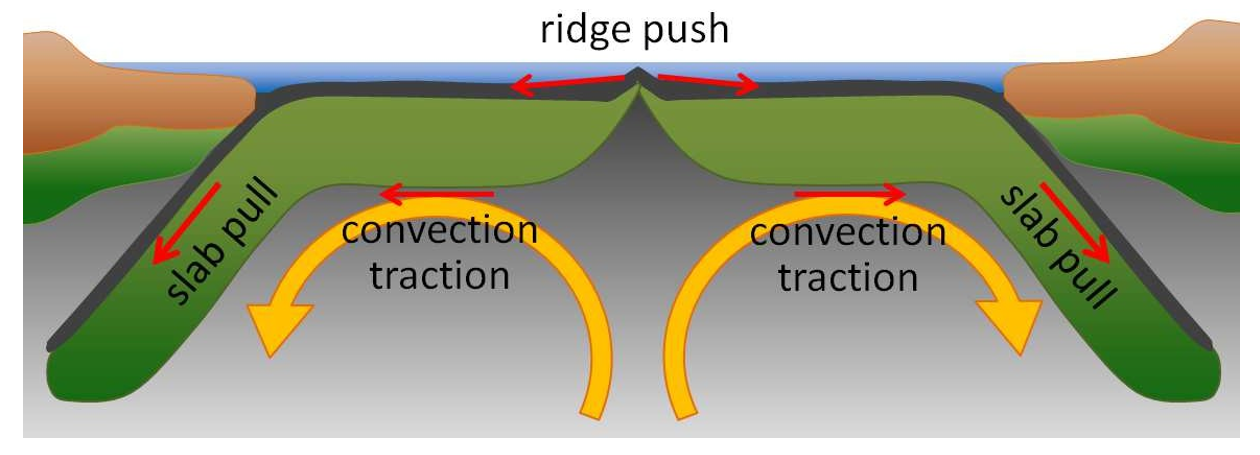 Figure 2: Factors that are responsible for plate movement during plate tectonics, convection and slab pull and ridge push forces [7].
Figure 2: Factors that are responsible for plate movement during plate tectonics, convection and slab pull and ridge push forces [7].
New oceanic crust and upper mantle is formed at the spreading centres of the oceanic ridges (Figure 4). Fresh basaltic lavas can be exposed on the seafloor at ridge crests [8]. These basalts are progressively covered by sediments as the seafloor spreads from the ridge axis. The heatflow at the ridges is many times larger than anywhere in the world. Cold seawater flow into the crust and is heated to form seafloor hot springs and black smokers.
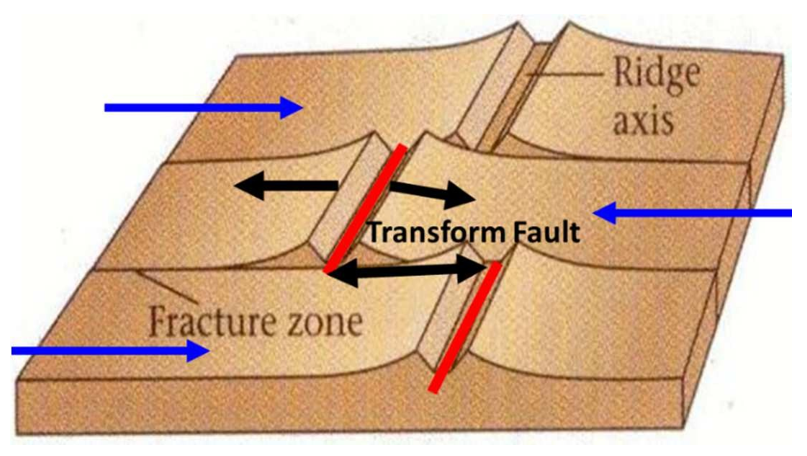
Figure 3: Oceanic ridge fracture zone perpendicular to the ridge axis. Plates slips laterally along each other and is called a transform plate boundary (modified after Marshak 2001) [8].
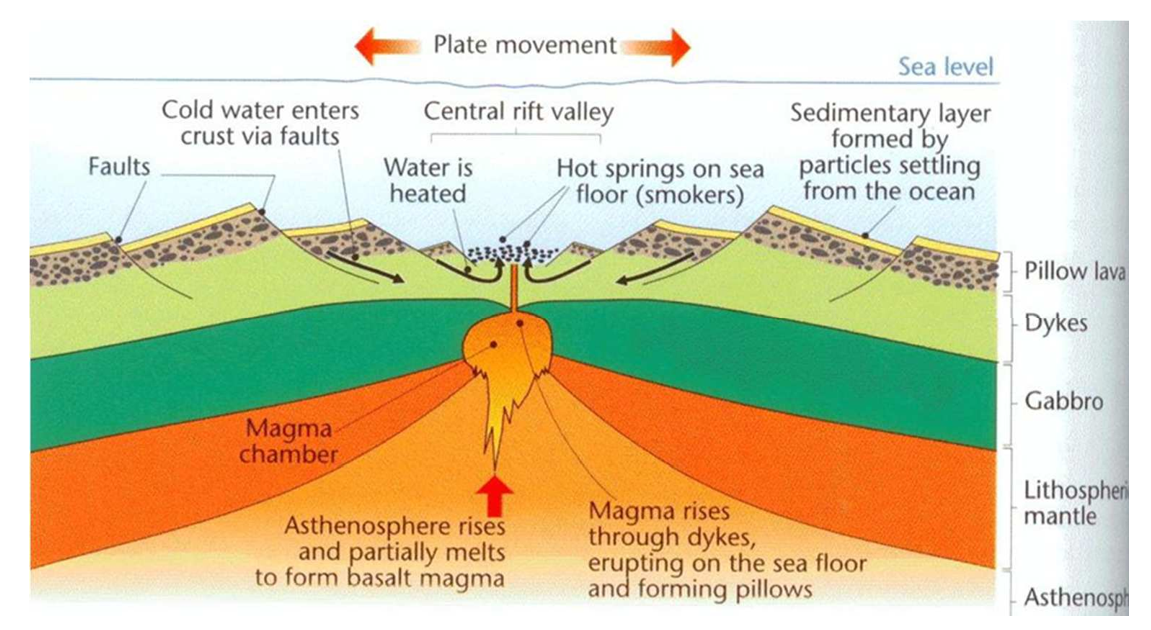 Figure 4: Mechanism of new crust formation at oceanic ridges (modified after Marshak 2001)
Figure 4: Mechanism of new crust formation at oceanic ridges (modified after Marshak 2001)
The depths over the oceanic ridges are correlated with the age of the oceanic crust with an increase in depth with age (Figure 4). Since the seafloor spreading is symmetrical around the ridge axis, the width of a ridge is defined as twice the distance from the crest to the point where the plate has cooled to a steady thermal state. Most of the cooling takes place within 70-80 Ma after formation [9]
Thermal Properties of Oceanic Ridges
Ocean floor heatflow is highest near the crest of oceanic ridges with the youngest oceanic crust. The lithosphere is thin and the interior mantle is at its hottest (Figure 4). The lithosphere cools as it moves away from the ridge axis by seafloor spreading. The average heatflow can be 100-250mW/m² for ocean floor younger than 10 million years depending on the distance from the ridge axis. The geothermal gradient can be as high as 80°C/km and temperatures as high as 350o C. At the young seafloor a significant amount of heat escapes (Figure 5) not by conduction through the crust and sediment cover, but through heated seawater called hydrothermal vents [9].
Ocean floor heatflow is highest near the crest of oceanic ridges with the youngest oceanic crust. The lithosphere is thin and the interior mantle is at its hottest (Figure 4). The lithosphere cools as it moves away from the ridge axis by seafloor spreading. The average heatflow can be 100-250mW/m² for ocean floor younger than 10 million years depending on the distance from the ridge axis. The geothermal gradient can be as high as 80°C/km and temperatures as high as 350o C. At the young seafloor a significant amount of heat escapes (Figure 5) not by conduction through the crust and sediment cover, but through heated seawater called hydrothermal vents [9].
As an example, the heat flow deficit of the Juan de Fuca Ridge over the sedimented sea floor (0.6-1.2 Ma) yield a cumulative heat loss of about 3MW/km (Davis et al., 1999). If the conductive heat flow over the bare-rock section (0-0.6 Ma) of sea floor is 100 mWm-2 where the seafloor sediment starts, then an additional 16 MW/km is lost over the bare rock for a total heat loss rate of 19MW/km. A value of about 20 MW/ km is a robust minimum estimated for oceanic ridge heat loss with less sediment and therefore a larger area to host open-exchange circulation for a typical sea floor age of 65Ma [11]. Heat loss for all oceanic ridges is about 10TW with about 2/3’s occurring in the sea floor younger than 8 Ma within 80 km on both sides of the ridge axis, as indicated in red on Figure 5.
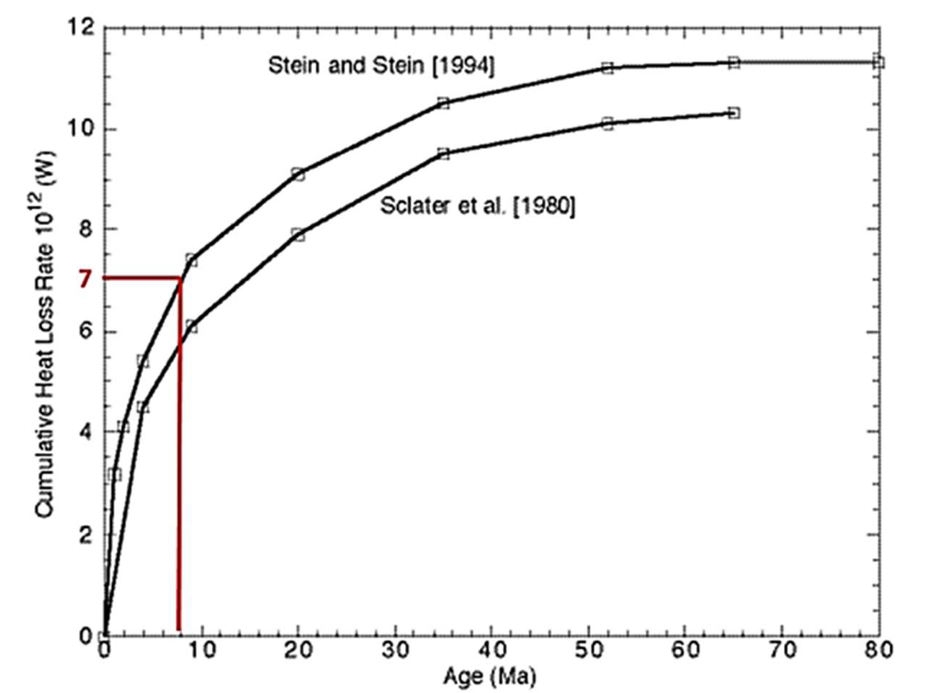
Figure 5: Cumulative heat loss rate for all oceans resulting from hydrothermal convection. The estimated heat loss rate at the young sea floor (< 8 Ma) is indicated in red (modified after Harris and Chapman [13]).
Oceanic Ridge Seismicity and Geothermal Fields
Geothermal energy is harvested in Iceland for house heating since 1928 and for electricity since 1969. The geothermal resources in Iceland range from high temperature magmatic systems (Treservoir >200°C) to medium temperature systems (Treservoir 120-150°C) as well as low temperature systems (Treservoir <120°C) (Flóvenz et al. 2015). Since 2018, Iceland has an installed electricity generation capacity of 755 MWe and an installed capacity for heating applications of 2.1 GWth, which totals approximately 2.9 GW of energy being utilised from the ridge axis [14].
The high temperature fields are all within the axial rift-zone of the continuation of the Mid Atlantic Ridge (MAR). The geothermal energy is related to active volcanic systems, cooling magma chambers or bodies in the crust. The uppermost 1km in the rift-zone comprises mainly of highly porous formations of young basaltic lavas and hyaloclastite (fractured reservoirs). The tectonics of the high temperature fields are associated with crustal rifting, normal faulting and transform faults. The low temperature fields are outside and the medium temperature fields closer to the volcanic rift zone (Flóvenz et al. 2015).
High seismicity is experienced in certain areas of Iceland and large earthquakes occurred with magnitudes from 5 to 7, corresponding to the thickening of the brittle crust and lower the heat flow away from the ridge. The return period of the large magnitude event episodes is about one century and can last from a few weeks to several decades. The recent large episode occurred in 1998 to 2008 (Flóvenz et al. 2015). A large pressure reduction occurred in the geothermal field due to production with the lowest values observed in 1998. Water level variations occurred prior to 2000. Injection of water into the Laugaland field was initiated to shorten the pressure recovery and in June 2000 it exceeded the maximum pressure level from the previous year. On June 17th 2000, a magnitude 6.4 earthquake occurred with the epicentre approximately 6km from the geothermal wells.
The seismic data show microseismic activity in the local magnitude range of -1 to 2. The background seismicity of 300-400 events annually prior to the 6.4 magnitude event, reduced slowly over time to a new background value of about 100 events annually at depths of 5-10km. Indications are that the geothermal production at Laugaland caused a reduction in fluid pressure of the fault system that might have delayed the large earthquake by approximately 18 years. The induced seismicity is associated with the extraction and reinjection which causes variations in the geothermal field pressure (Flóvenz et al. 2015).
Discussion
The earth cools continuously and the estimated heat loss is about 14 TW [5,6]. Heat loss for the entire oceanic ridge system is about 10 TW of which about 2/3’s of the heat loss occurs in the sea floor younger than 8 Ma, within 80 km on both sides of the ridge axis [13]. Using the Juan de Fuca Ridge (Davis et al. 1999) as an example, bare rock very close to the ridge axis is mainly responsible for a total estimated heat loss of about 20MW/km as a robust minimum for oceanic ridge heat loss. Ridges with less sediment with a larger area for open-exchange circulation is a typical sea floor age of 65 Ma [11].
Seismicity is common at oceanic ridges. Iceland is situated on an extension of the MAR and demonstrates the seismic behaviour when geothermal energy is utilised from an oceanic ridge. Current indications show that low magnitude (>2.0Mw) seismicity is induced due to extraction and reinjection of the working fluid causing pressure variations in the geothermal fields (Flóvenz et al. 2015). Iceland reported large magnitude earthquake episodes once every century (Flóvenz et al. 2015). Indications are that the geothermal production at Laugaland caused a reduction in the fault system fluid pressure that might have delayed the magnitude 6.4 earthquake in 2000 by up to 18 years.
Conclusion
The modified Kardashev scale by Ćirković and Kaku, proposes that a Type I civilization could control plate tectonics and earthquakes, on top of harvesting all the energy from the planet. Studies indicate that 70% of all heat losses through the oceanic crust occurs at or close to oceanic ridges.
Indications from Iceland, suggest that removing energy from ridge systems may delay earthquake events. If the geothermal energy at the 2.6km deep oceanic ridges can be harvested at a sufficient rate, it may be possible to at least delay large earthquakes, reduce the frequency and possibly the magnitudes, especially when reinjection is not needed to stabilise pressures. This could enable earth as a Type 1 civilization to influence plate tectonics and earthquakes while harnessing the energy of the planet.
References
- Kardashev NS (1964) Transmission of Information by Extraterrestrial Civilizations. Soviet Astronomy Journal 8(2).
- BP (2020) Statistical Review of World Energy 69th edition.
- Cirkovic MM (2015) Kardashevs Classification at 50+: A fine vehicle with room for improvement. Serbian Astronomical Journal 191: 1-15.
- Kaku M (2016) 7 Types of Advanced Cosmic Civilizations.
- Michaelides EE (2012) Entropy production and optimization of geothermal power plants. Journal of Non-Equilibrium Thermodynamics 37(3): 233-246.
- German CR, Lin J (2004) Mid-Ocean Ridges: Hydrothermal Interactions between the Lithosphere and Oceans. Geophysical Monograph 148, American Geophysical Union.
- Kearey, Vine (1996) Global Tectonics (2nd ed), Blackwell Science Ltd. In: Oxford.
- Marshak S, Earth: Portrait of a Planet, (1st Edn), W.W. Norton and Company, New York and London, ISBN 0 393-97423-5.
- Stein CA (1995) Heat Flow of the Earth, Global earth physics: a handbook of physical constants. In: TJ Ahrens editor, AGU Reference Shelf 1, pp: 144-158.
- Stein CA, Stein S (1994a) Comparison of plate and asthenospheric flow models for the thermal evolution of oceanic lithosphere. Geophys Res Lett 21(8): 709-712.
- Stein CA, Stein S (1994b) Constraints on hydrothermal heat flux through the oceanic lithosphere from global heat flow. J Geophys Res 99: 3081-3095.
- Hasterok D, Chapman DS, Davis EE (2011) Oceanic heat flow: Implications for global heat loss. Earth and Planetary Science Letters 311: 386-395.
- Harris R, Chapman D (2004) Deep-seated oceanic heat flow, heat deficits and hydrothermal circulation. In: Book Hydrogeology of the oceanic lithosphere. In: Cambridge University Press, pp. 311- 336.
- (2020) Energy Authority of Iceland.
Citation: C J S Fourie (2022) Can Earth as a Level 1 Civilization control Plate Tectonics and eliminate Earthquakes by harnessing the Energy of the Planet? Current Trends in Eng Sci. 2:1011

